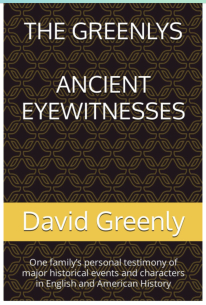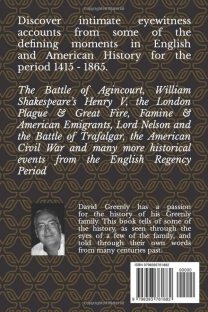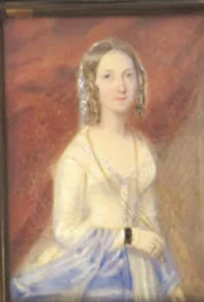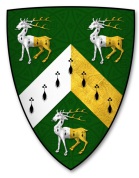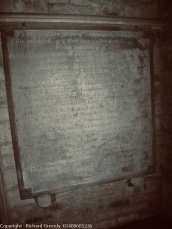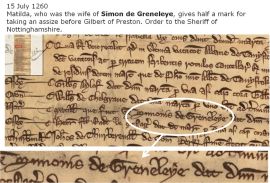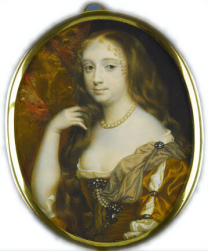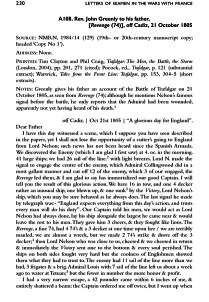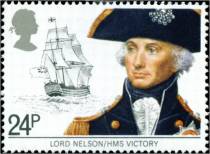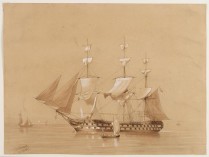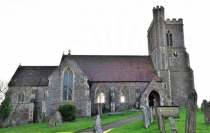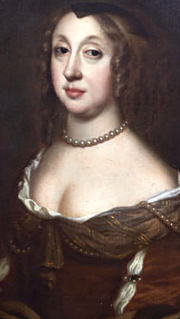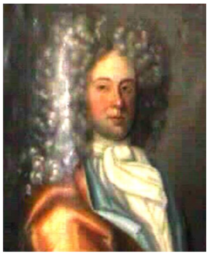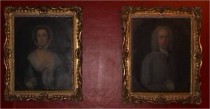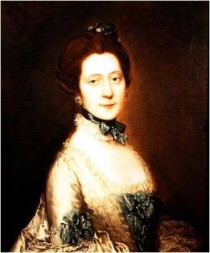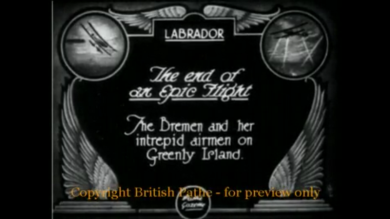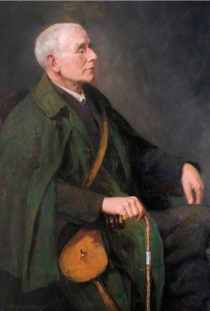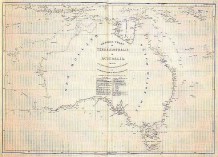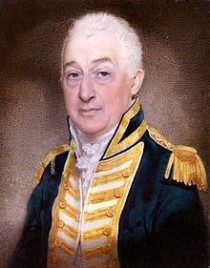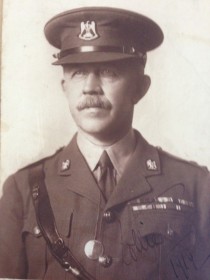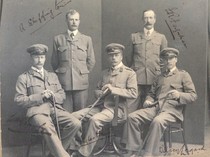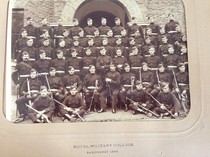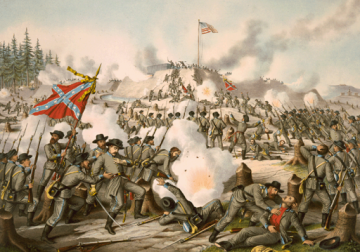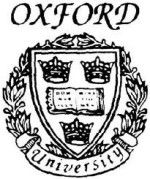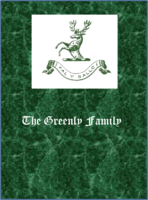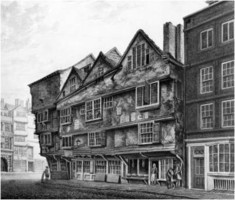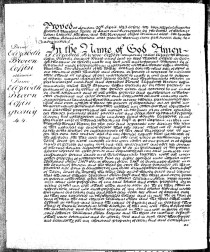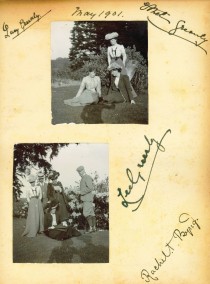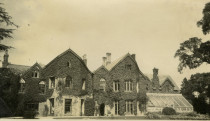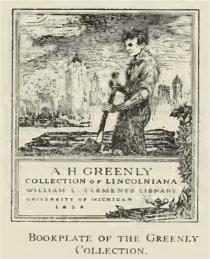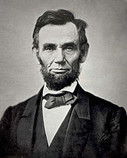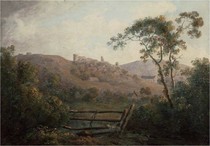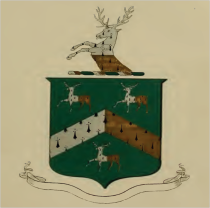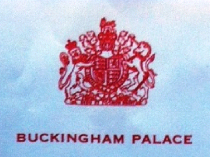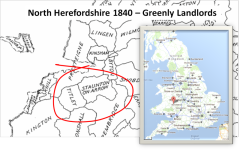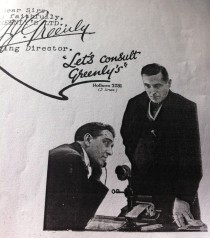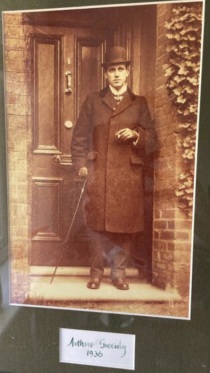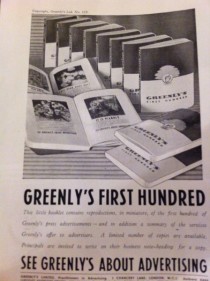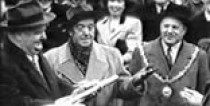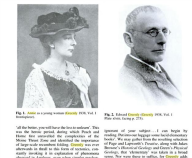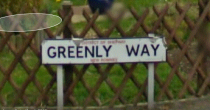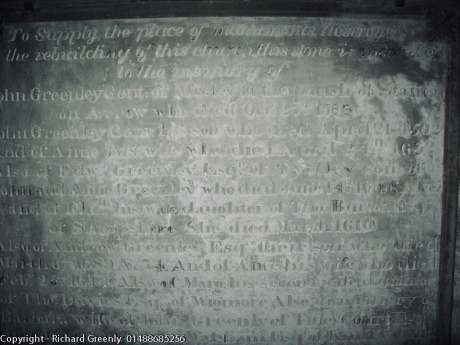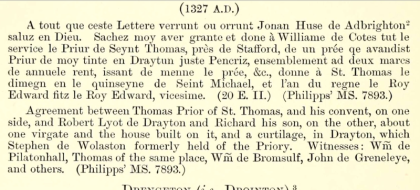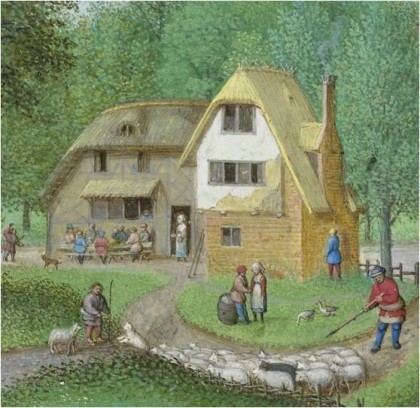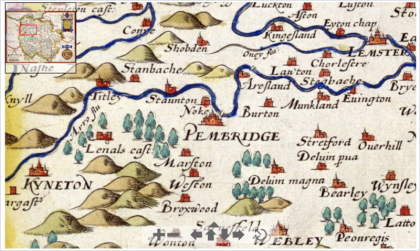THE GENTLEMEN OF MOWLEY AND TITLEY - THE[...]
Adobe Acrobat document [313.7 KB]
The headstone below in Titley Church provides the link between the Greenlys in Staunton on Arrow and later in Titley. It commenorates John Greenley gentleman of Mowley in Staunton on Arrow and his sons who lived and were buired in Titley Church having lived in Titley and at the manor house Titley Court also in Titley.
John Greenley Gent of Mowley Died 27 Oct[...]
Adobe Acrobat document [552.9 KB]
Greenly History.pdf
Adobe Acrobat document [555.2 KB]
A true story of an ancient family history ....
This is how the cleared land in the wood by the river may have looked in the late first Century. The 'greneleye' as it was known was in Staffordshire and is known as Grindley today.
The Greenly familiy lived in this clearing by the river and the familiy was known as 'de Greneleyes' - meaning in Ancient English a green cleared land. Over the centuries the 'de Greneleye' name was simplified - eventually -to Greenly.
We know this because many of the family's will and testaments have been recorded for the National Archive and we can see how the family name changed as the years rolled on by.
We can also see from the Archives how the familiy was concentrated around North Herefordshire (Stauton-on-Arrow, Mowley and Titley) and Staffordshire (Greneleye).
A long, long time ago, when England was being ruled by the Saxons, around 350AD to 1,000AD, a man and his family made a clearing in a wood and a barred gate was used to enclose the cleared land. We’ll call the senior member of the family John*. The area that John and his family cleared became known locally as Greneleye; this word being a combination of two ancient English words (pre 600 AD) for Green, Grene and leye; meaning a clearing of a wooded area.
*John was the first name given to the first borne sons of Greenly's for hundreds of years (see Greenly Wills section).
John and his family and his ancestors before them had probably lived in that area for thousands of years, probably through the stone and bronze age, and the Roman and Viking invasions. At some point they were granted permission - by the Church or by Royalty - to clear and enclose that area of land possibly around 600 AD. We can guess at this date with some accuracy as the name of the field that was cleared is documeted in the National Archives and we can trace our families movements from that field forwards over the next 1,500 years.
A thousand years ago, people were given a first name (a Christian name, often the same as one of the disciples) and to identify them further, they were referred to as the elder or younger (father or son of), and sometimes also from the place they came from. For example, John the Younger Son. Over the years this would simplify to John Younger or John Youngson.
Our ancestors took the second name from where they came from and would have been ‘of Greneleyes’, or ‘of a Green Clearing with a gate'. So, John was known as John de Greneleye, and his family were also de Greneleyes too.
Today that very place that was cleared in the woods and was enclosed with a gate, and was knowb locally as Greneleye, still exists and is now known locally as Grindley, near Uttoxeter in Staffordshire.
Names were very important as most people were illiterate and needed a way to refer to other people. John Oak lived by the oak tree. Simon Brooke lived by the small stream. John Meadow lived near the meadow, and so on.
Also, all fields and roads and paths had a name to allow people to agree where to meet. For example, low meadow, old oak road and holly lane.
By the late 1,000’s the Greneleye’s had already lived through much of the formative history of England and were soon to see another invasion. In 1066 the Normans, from an area in Northern France, invaded the south coast of England.
Led by King William, the Norman army defeated the Saxon King Harold at Hastings (Harold was killed being famously shot in the eye with an arrow).
Quite what the impact would have been for the Greneleyes we can only imagine, but we do know that the area where the Greneleyes lived, Staffordshire, was an area of ongoing rebellion against the Norman invasion from 1066 until 1072.
One certain change that would have resulted as a consequence of the Norman invasion, would have been the use of the French language being adopted throughout England. So John of Greneleye, as he’d have been known locally for hundreds of years, became John de Greneleye.
Towns in those days were very small by modern standards. There were only around 1,000 towns existing in the whole of England. These towns would have populations of only a few hundred and at the very most, a few thousand; even London, a large town, at this time only had a population of 20,000. York and Winchester, two important religious towns would have had populations of around 10,000.
The whole population of England would be around 2 million people; that’s the equivalent of 30 modern football stadiums.
However, the vast majority of people still lived away from these towns, living in their extended family groups, grouped around settlements, as they had done from pre-history times.
The extended family of Greneleyes lived on their cleared land. Greneleyes, like everyone else, except a few early tradesmen who had set up in towns, lived on and off the land where they lived. Meat (Beef, Pork and Lamb) were the main staple of the diet at this time – supplemented by what could be grown on the strips of ploughed land or picked from trees and hedges.
The Greneleyes had enclosed their land to keep their Cattle and Sheep safe, and the cleared land could be ploughed in strips using Oxen. They also had access to woodland, crucial for fires and timber for building. The Greneleyes also had access to a nearby river, the river Blithe.
The land in England in those days had been organised around Shires, named after a significant Town (e.g. Stafford the main town in Staffordshire). The shires were further divided using a system of division called ‘hundreds’ which were essentially Manors; of which there would be a Lord of the Manor.
Typically, the 'Land Lord' would be paid a rent by those who worked his land and who would also be bound by his Manorial law to provide a share of whatever they produced from it. The Land Lords possessed total jurisdiction over the tenants; they could even buy and sell them as chattels.
The 1,000’s AD is the time of our Great, great, great, great, great, great, great, great, great, great, great, great, great, great, great, great, great, great, great, great, great, great, great, great, great, great, Grandfathers; that’s about 26 generations.
There is plenty of evidence to support the assertion that Grindley or Greneleye is where we descended from. Key evidence, comes from the published ancient history of places and surnames in England, which clearly shows the name Greneleye and its derivation to Grindley in modern Staffordshire. Further strong evidence is from the many wills and testaments that show the transformation of the familiy surname from Greneleye to Greneley, then to Grenely and onto Greenely and finally to settle at Greenly.
Finally, our surname name Greenly is rare, even today there are very few Greenlys in England. When the wills of 1550’s to the modern day are examined there are few Greenlys, and, they are concentrated in the area around Greneleye in Staffordshire and later around North Herefordshire.
Additionally, the Greenlys have some notable individuals and this fact, coupled with the rare name, has meant that considerable material about the family from ancient times is available.
It’s a reasonable assertion to state that any Greenly that has lived from the 1400’s AD and probably from the 600’s AD can be traced back to the same family; what is more, most of the Greenly's in England from 1500 AD to modern times can be located into a branch of the Greenly Family Tree.
This tree has been drawn up as a huge wallchart.
So, there we were then, our ancestors are grouped around an ancient settlement, in a wooded clearing, and they’ve fitted the clearing with a ‘barred’ gate. They were self sufficient, and within a day they could make a trip to the town of Uttoxeter in Staffordshire (which was established during the Roman invasion of a thousand years earlier).
The Greneleyes were landowners and possibly allowed a few others to settle in the Greneleye and pay a rent or share their spoils with them. The land was a probaby few acre’s large – say a couple of football pitches. They probably lived in a wood framed Cottage.
As we’ll see they soon start to appear as significant people and therefore we can assume they were acquiring lands and therefore rent. This moved them from the realms of peasent to ‘gentlemen’ or Yeoman; men who did not have to work manually themselves but could live off the rent and labours of others on their estates.
1230AD
Our earliest recorded mention, so far, is in the reign of Henry III in 1230 AD. Simon de Greneleye, was in dispute with another man – probably over land rights, as it invariably was back then. This land dispute theme carries on with the Greneleyes right up to and including the late 1500’s. The Reports of Sir Edward Coke, Knt. [1572-1617], were used to set important legal precedents for future legal cases. The case of ‘Greenly v Greenly’ still sits on the English Legal statutes as the precedent for a specific case of land being passed to others on death where no will was made.
1305 AD
Galfrido (Geoffrey) de Greneleye was held in high esteem as he gave his warranty and seal to a document of the Chartulary of St. Thomas's Priory, which was written by his son Willielmus (Willaim) (Note: The priory of St. Thomas the Martyr on the north bank of the Sow two miles east of Stafford was founded about 1174).
1328 AD
Next comes William de Greneleye in 1328, son of Geoffrey mentioned above. Once again there was a dispute over land ownership, this time with Nicholas de Denton. The land in dispute was at Bromeleye Baggot in Staffordshire, a few miles from Greneleye. William and his wife, Sybil, lost the claim to the lands, although Nicholas had to pay them 10 Marks.
1348 – 1351 AD
The Black Death, or bubonic plague arrived and was devastating. It threw England back many years to a state where people were just able to produce enough to survive and there was little surplus to be sold at markets etc.
Also the population that were able to carry out work on the land was dramatically reduced – as many as half of all people died; possibly 1 million people. This was a dramatic time for the Lords of the Manors, as there was simply not enough peasants’ alive to work the land. Additionally, the peasants would no longer stand for poor conditions and the brutal rule by these Lords. Although there were less people, they focused their efforts on the higher quality lands and much of the poorer lands and settlements would have been abandoned.
This was a time for the peasants to live more comfortably than previously and without the heavy burdens of the previous Manorial Land Lords power.
During the plaque, a family was often divided to live separately in an attempt to reduce the chances of the whole family succumbing. Often, the family would be split across a river as they believed, or rather hoped, that the plaque would not travel across water.
1436 - 1437 AD
In the 1430’s we have a Thomas Greneleye, as a Vice Chancellor of Oxford University, twice in 1436 and 1437. We can see from Simon, William and Geoffrey Greneleye above that the de Greneleyes had been an educated family from the 1200’s, and were significant enough to appear in proceedings presided over by Royal commissioners in matters of land ownership disputes.
Interestingly, the land at Greneleye was part of a dispute between Elizabeth Ferrers, former wife of knight Sir William Ferrers and several noted others. So the Ferrers must have come to claim the land from Nicholas de Denton, or his relatives. Elizabeth lost the claim to the lands and many others pieces of land, but was paid £1,000 for her troubles. A very large sum back then.
But we can see from this that there is no mention of the original de Greneleyes but one of them has gone on to be a vice chancellor at Oxford University.
I wonder if the original loss of the land to Nicholas de Denton was the spur for the family to walk through that barred gate for the last time and make a journey that would eventually see them settle around the north of Herefordshire. Indeed, they may have had to leave the land as it was no longer theirs or it was the impact of the Black Death. However, they were clearly industrious and had money from the sale of the land; so my guess is that sometime in 1328 or soon after, the Greneleyes closed their gate behind them and made a journey of some 100 miles to Staunton on Arrow in Herefordshire. There are no more records of Greneleyes in Staffordhsire after this time. All further records are from Herefordshire; and specifically the area in north Herefordshire around Staunton on Arrow, Mowley and Titley.
1450 AD
The Greneleyes are now living and thriving in and around the small settlement called Staunton on Arrow in Herefordshire.
This was the time of Henry V and the ongoing battle with France which had raged for 100 years (The 100 years war) and ended in 1453.
The famous battle of Agincourt was in 1415, when the English bowmen wreaked havoc with the French. In England, Archery was a mandatory sport, to be practised each week. This practice evidently paid off at Agincourt.
The legend goes that the inferior French bowmen had their first two fingers chopped off to prevent them firing a bow again. The English taunted the French by sticking their two fingers up into the air to show that they still had theirs. Hence the two-fingered ‘V’ sign as a gesture of offence.
No doubt some Greneleyes would have served in the battle with the French, as armies were mustered from all the towns and villages of the land; perhaps a few raised the two finger salute to those unfortunate French.
1500’s AD
The Tudor Family dynasty was established at the start of the 16th Century with Henry VIII ruling from 1509 – 1547.
The last mention of a Greneleye was Thomas as Vice Chancellor of Oxford University, the next mention is in 1500.
1500 AD
John Greneleye of Mowley born 1500 died 1572, was granted the Manor of Woodhailhill in Staunton On Arrow in 1525. This grant was from Henry VIII. (From the papers of Lady Elizabeth Greenly, held at Hereford Records Office).
John Greneleye, holds the evidential key to the collateral ancestral link for our family and that of all other Greenlys, anywhere in the world after that date. This includes the Greenlys of Titley Court, the famous Henry Greenly of railway fame, the famous Greenly who served with distinction in the American Civil War and at Trafalgar, Lady Anne Greenly who had her portrait pained by Gainsborough, Greenly Island in South Australia and Greenly Island in (Nova Scotia New Scotland) in Canada / Alaska, the Greenly advertising Agency in London, which created Bertie Basset to brilliantly promote a liquorice confection, and to you and me and all of ours.
This John is also mentioned in a Church in Scotland; ‘Prebend of Corstorphin called half Dalmahoy and half Haltoune pertaining to Sir John Greneley, (died 1568) £13. 6s. 8d.’
Clearly, our ancestor is gentrified, a Lord of the Manor of Woodhailhill, a district of Staunton on Arrow, he is educated and mobile. And remember this is our direct ancestor. We share his DNA.
All the following references are from wills (some Greenly and some others that mention a Grenly or surname variant); but all from Staunton on Arrow or thereabouts (e.g. Mowley, Titley). I have standardised the names to Greenly in most cases, but the use of Greneleye, Greneley, Grynlie and a few variants is used throughout.
The variations on the names was not unusual as the recorder would have to rely on their own spelling ability as there would be no other reference material. But for sure they are all the same family name as all the wills provide a timeline between the deaths over many hundreds of years.
1539 AD
Stephen Grynlie is mentioned in a will of Staunton on Arrow. Probably the son of John. My guess therefore is that Stephen is also from Mowley. Mowley wood is an medieval wooded area near Staunton on Arrow.
1546 AD
Phelypp GRYNLIE of Moldley [today called Mowley] and his wife Sibell are mentioned in a will of Staunton On Arrow.
1551 AD
Phelippe GRENLY of Moldeley the elder; to my godchildren: Phelippe GRENELYE. This is the above Phillip and his new son; hence the elder reference.
Later that year, 1551, Philip the yonger Greenly, is mentioned in another will.
1552 AD
Both Philips, Elder and younger mentioned again. As is Richard and Stephen Greenly; probably other sons of Philip the Elder.
1559 AD
Philip the Elders wifer is mentioned; Isabell daughter of John Walsall.
1563 AD
Philip and John Greenly mentioned.
1578 AD
GRENELYE, Phillip - yeoman, of Staunton on Arrow, 12 Jun 1578 [Elizabeth I reigns] Note YEOMAN A freeholder, the next class down from gentry.
Mentions, John and Philip Greenly (sons), Stephen, child of John or Philip, Richard (son), John (son of Richard), Thomas Greenly.
1583 AD
Anne, child of Elizabeth Greenly, Philip Greenly (the younger), Stephen Greenly, John Greenly of Mowley.
1585 AD
John Greenly, Gentleman of Moldley (from memorial stone in Titley Church) – mentioned in 1583 will above.
1588
Stephen and Phillip Greenly
1589
Roger Greenly, son of Philip Greenly
1591
Philip, Roger and Thomas Greenly
1591
Richard. Stephen, Philip and Ellen Greenly.
1593
Roger Greenly (son in law of Woodhouse), married Anne Woodhouse and Philip Greenly.
1598
Will of Thomas Greenly, Mouldley, Yeoman.
Mentions wife, Ales, son Richard (assumed to be the eldest as specially mentioned to inherit land etc), also sons, Philip, John, Edward, Thomas and daughter Anne Greenly.
1600
Will of Richard Greenly
Mentions wife Sybil, John Greenly and son of John Greenly, Yeoman, Jane, Margaret, Ursula, Anne, Elizabeth, Sibill Greenly all daughter of John Greenly, Yeoman deceased.
Edward Greenly, son and heir to John Greenly, Yeoman deceased – all land and properties in Mouldley and Titley.
1614
Will of Philip Greenly, Staunton on Arrow, mentions wife Alice.
1617
Philip Greenly, must be the younger as elder died above in 1614.
1625
Will of Philip Greenly, citizen and butcher of London 4th October 1625.
To son John Greenly, house and lands in Staunton on Arrow, to Philip his brother £200, daughter Alice (Rawle).
House and slaughterhouse in London left to wife, Alice who lived until 1639.
1630
Mary Greenly mentioned in will of Henry Steade, Citizen and Grocer of London. From his will he appears to be from Titley area also.
1639
Ales Greenly wife of Philip Greenly of Titley; their son Edward Greenly (cousin of Elizabeth Lydd formerly RODD) their daughters Elizabeth Greenly and Margery Greenly.
To sisters of Philip Greenly, Katherine Greenly and Sibill (Mellen / Melling)
1639
Will of Alice Greenly, wife of butcher Philip who died in 1625 above. Owned property by St. Pauls Cathedral and slaughterhouse near Smithfield meat market.
Henry Greenly, butcher, and son Philip Greenly are mentioned.
1652
From will of Frideswide RODD
Mentions his god daughter Fridewide Greenly.
1656
Will of Phillip Greenly, Titley, Yeoman, to be buried next to son James Greenly buried in Titley Church.
Sons William Greenly (inherited most), Richard Greenly and Andrew Greenly, youngest daughter, Ffrydayswood Greenly, daughter Elizabeth Greenly, Margery Greenly (Lerigo), Charity Greenly and son of Charity, Richard Greenly.
Overseers were his beloved friend the Dodds, Richard and James.
1666 – Black Death returns and Great Fire of London would have destroyed much of the property of owned by the descendants of Philip Greenly the Butcher.
1684
Will of Richard of Titley, Yeoman
Som mentioned in will of his father Philip in 1656.
All to wife Joanne, then to daughter Elinor.
1717
Will of William Greenly of Titley. Tailor.
To son William, lands in Manor of Titley, wife Mary all lands in the parish of Kinnersley co. Herefordshire.
Witness: Frances and John Greenly.
1723
Will of William Greenly, Titley.
Mentions wife (but not name), sons James, daughters Elizabeth, Katherine (Jones), Grandson Andrew Greenly, granddaughter Elizabeth,
Witness – signed John Greenly.
1729
Will of John Greenly, Esquire of Titley.
Son Edward, title and estates called Court of Marston in the parish of Pembridge, Herefordshire.
Daughter, Phoebe.
Son John.
1730
Will of Stephen Greenly
Brother Richard – one shilling!
Brother Henry (deceased), his sons Stephen and Thomas.
Sister Mary, plates marked SEG.
Sister in law Mary Greenly, widower of brother William Greenly. Their son Willaim.
1750
Edward Greenly, of Doffers Common, London Esquire. (2nd Cousin to Lady Elizabeth Greenly).
A very valuable estate.
Wife (no name) to have Norbiton Hall and estate lands in Kingston co Surrey.
Son of Edward Greenly,
Daughters, Mary, Elizabeth and Anne Greenly.
Executor, Sir John Phillips of Picton Castle. Lady Anne Greenly married Edward Greenly the son mentioned above – he inherited the title as she was Anne Phillips of Sir John Phillips of Picton Castle.
1754
Will of John Greenly – Titley; Esquire.
Property and land in Titley and Staunton on Arrow, several Lordships and estates given away to the Earl of Powys.
Daughter Catherine and Elizabeth.
1826
Will of Thomas Greenly
Wife Frances, brother John Greenly,
1843
Will of Lady Elizabeth Greenly, Titley Court, 4th December 1835.
All titles and estates given away to a dear friend Louisa Elizabeth Hastings (later Lady Hastings), then after her death to Charles Willaim Allen; son of Henry Allen esq. Being descended on his mothers side from a daughter of great grandfather John Greenly esq. Of Titley. By Dorothy his Third Wife.
Lady Elizabeth would have ben very well aware of the Greenly's in Statunton on Arrow, who were collaterally descended from her earliest ancestor, John Greneleye of Mowley, from the 1400’s and he from the de Greneleyes of Staffordshire from time immemorial.
In 1835, our Great, great, great, great grandfather was John Greenly, married to Elizabeth Turner. This John would have been the ancestral heir to the Lord of the Manor of Titley, and all its lands and titles.
Who knows how things may have worked out then for the Greenlys and descendants of this John.
They had 8 children, including John who was born in 1835. This John, my Great, Great, Great Grandfather married Ellen Ferrer, in 1869 (a cousin of the Earl of Ferrer).
They had 6 children, including William Greenly, our Great Grandfather. William married Amelia Fox in 1899.
They had 6 children, including Lilian Sandford Greenly, mother of Cyril Percy 'Jack' Greenly.
Other children of William and Amelia were, John Greenly who had a son Gwillam (cousin of Cyril), Francis James Greenly (Frank), who had two sons Frances Derek and Malcolm Gerald.
These were also cousins of Cyril Greenly.
